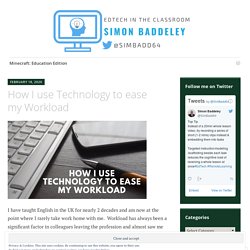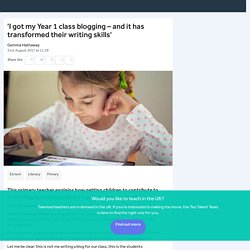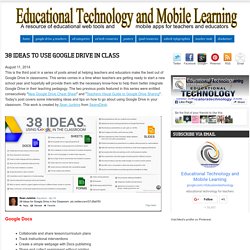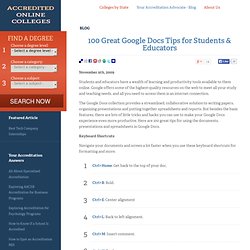

How I use Technology to ease my Workload – SimonBaddeley64. I have taught English in the UK for nearly 2 decades and am now at the point where I rarely take work home with me.

Workload has always been a significant factor in colleagues leaving the profession and almost saw me leave under my previous Multi Academy Trust. It doesn’t have to be this way. I have always been a keen technology enthusiast in education but firmly believe the technology should be the best supporting actor not the star of the show. In fact, if you were to call in to one of my lessons, you would be forgiven for missing it entirely with the exception of my visualiser which is extremely prominent. The way I employ technology to support my workload has however made massive reductions to my working day and actually permeates every single thing I do. Planning Planning lessons is one of the biggest workload contributors and quite rightly so. Calendar. 'How blogging improved my Year 1s' writing skills'
“Has Doreen been on yet?”

That’s the shout that starts most of my Year 1 classes each day. The call is followed by children running into the class to see if they have any more flag hits or comments on our class blog. Doreen refers to an educational consultant from Australia (@doreen_blyth), who visits our class blog regularly and praises the work that the children post independently. Let me be clear: this is not me writing a blog for our class, this is the students themselves writing. Five- and six-year-olds with a blog? It began because writing had been on our school development plan for a long time and we felt we needed a new approach to encourage children to write independently. Children blogging independently We decided we needed some help getting things started, so we recruited David Mitchell (@deputymitchell). I was in Year 2 at the time and couldn’t wait to get the class up and running on the blog.
Don’t teach digital citizenship — embed it! Google Apps for Education: Tips & Tricks. Leveraging Web 2.0 tools like Google Apps is a powerful learning strategy in the 21st Century.

But how do you choose the right tool that will enhance classroom learning and not be an afterthought or add on? We’ve put together some best practices for Google Apps for Education. Collaborate Students, colleagues, and professionals can share ideas, give feedback, produce meaningful products and more! Collaborate on a singular document (versus sending multiple versions back and forth via email)Upload and convert document files (up to 2 MB)Work together synchronously or asynchronously Share Documents can be made private, public or shared with just a few peopleGoogle accounts aren’t required for everyone to collaborateInformation is stored in the cloud and can be accessed 24/7 Use the Templates App Free templates include teacher and student planning tools, evaluations, rubrics, newsletters and more!
Use the search feature Organize. 38 Ideas to Use Google Drive in Class. August 11, 2014 This is the third post in a series of posts aimed at helping teachers and educators make the best out of Google Drive in classrooms.

This series comes in a time when teachers are getting ready to start a new school year and hopefully will provide them with the necessary know-how to help them better integrate Google Drive in their teaching pedagogy. The two previous posts featured in this series were entitled consecutively "New Google Drive Cheat Sheet" and "Teachers Visual Guide to Google Drive Sharing". Today's post covers some interesting ideas and tips on how to go about using Google Drive in your classroom. This work is created by Sean Junkins from SeansDesk. 100 Google Docs Tips. November 9th, 2009 Students and educators have a wealth of learning and productivity tools available to them online.

Google offers some of the highest-quality resources on the web to meet all your study and teaching needs, and all you need to access them is an internet connection. The Google Docs collection provides a streamlined, collaborative solution to writing papers, organizing presentations and putting together spreadsheets and reports. But besides the basic features, there are lots of little tricks and hacks you can use to make your Google Docs experience even more productive. Here are 100 great tips for using the documents, presentations and spreadsheets in Google Docs. Keyboard Shortcuts. iPad in Education. Appear.in – one click video conversations.
Expedition Everest – Thematic Learning. The way that meaningful learning contexts and extended projects can be embedded in the primary classroom has always been a research and pedagogical interest of mine.

I have developed many projects during my time in the classroom including the Brer Rabbit Critical Literacy project I ran in collaboration with The Wren’s Nest museum in Atlanta, USA. The most successful projects have included: An open-ended theme with a range of text types and curriculum areas embedded.An external and relevant collaborator with expertise linked to the theme of the project.
I was very thankful to The Wren’s Nest for being involved in our Year 2 animation project as our live storytelling session was a real highlight to the project and added a global (and historical dimension) to our project. Maximising the Potential for Interactions Online.